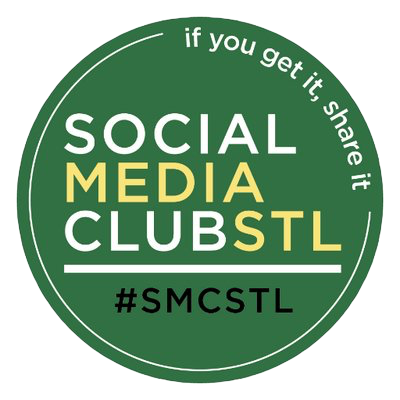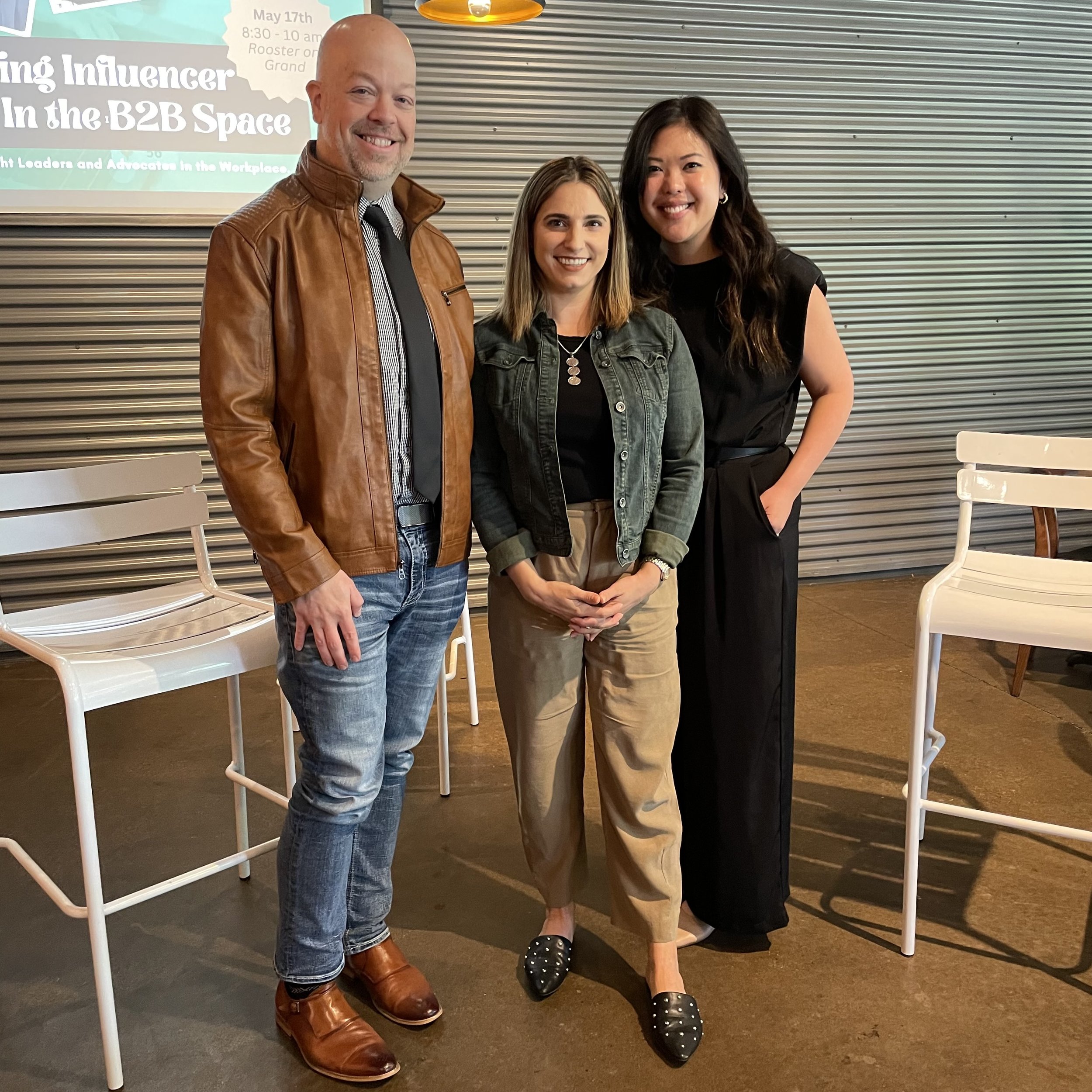May 17th, we were lucky to be joined by Mike Allton, Head of Strategic Partnerships at Agorapulse, and Marisa Lather, Director of Marketing & Communications at Bridge Partners, to speak about B2B influencer marketing. Our panel was moderated by board member Alicia Underwood. Here are the highlights from our discussion.
Meet our speakers!
R to L: Mike Allton, Marisa Lather, Alicia Underwood
What is the difference between B2B and B2C influencer marketing?
Common differentiators of B2B:
The products tend to be more abstract, esoteric, and less visually appealing products/services in the B2B space.
There are often longer buying cycles that might also mean an extended pipeline.
There is probably more of a lead funnel than in B2C, which tends to be more direct response focused.
B2B marketing often requires more education, which is ideal for influencer marketing.
Rarely is there a single touchpoint in B2B.
“In B2C, we care less about who is following the influencers. In B2B, reaching decision-makers is crucial. The number of followers is less significant. Who they are talking to and what they are talking about is more important,” said Marisa Lather, Bridge Partners.
Relationships
Building relationships with influencers is critical in B2B. Long-term relationships breed authentic content. No one should read from a script or use cookie-cutter messaging when you’re talking to an audience that likely already knows a substantial amount about your product or the problem that it addresses.
Our panelists recommend having relationships with multiple influencers so that you can engage them for specific campaigns and have them work together as a team. The ability to network is huge in deciding who your influencers should be as well as having the right technology to manage and source those influencers once identified.
Mike provided an example regarding Adobe inviting several influencers to an event and having them sharing and promoting each other’s content to amplify their message. Some key takeaways from this example:
B2B influencers might be stronger networkers than B2C influencers.
You need to have relationships with influencers – B2B is not as transactional as B2C.
If you can get your influencers to work together, you create the potential for greater results.
The Path to Influence
Mike takes a very organic and natural path to engaging with potential influencers for his brand.
Connect on LinkedIn
Offer free resources and content to share on their channels
Keep an eye out if they talk about your brand
Regarding content, let the influencers be the creative resource. Mike doesn’t like creative briefs. He believes in setting goals for the campaign and letting influencers come up with the messaging that will resonate with their audience. Provide your influencers with context and resources in addition to creative freedom.
“Setting expectations with your influencers is important,” said Marisa, “Here is where we are trying to go. You decide how to get there with your audience.”
Measurement and Affiliate Tracking
There are some obvious challenges when it comes to influencer marketing and B2B. Use UTM, bit.ly, etc. to create specific links for influencers to use to measure and track their impact. This directly points to where the traffic is coming from and attributes it to the influencer specifically.
Are people talking about us in person at events? There isn’t link tracking available for that, but knowing someone had a slide about you or created that brand awareness is beneficial in tracking activity. If influencers use Word of Mouth (WOM), have them tell you when and where, so you can attribute spikes in activity directly to them (if and when they are effective).
Business Considerations
Understanding your obligations as a brand and their obligations as your influencer(s) is the biggest piece. Influencers must disclose their relationship with you in every piece of content they are pushing out in the interest of your brand (#ad, #affiliatecommision, #partnership, etc.)
Navigating Compliance
Marisa works for a tech consultancy while Mike works for a SAAS company.
Common considerations:
GDPR
Ethics
Political stances/messaging (this has shifted)
Since B2B influencers might have smaller audiences, they might have less experience in knowing when and how to disclose relationships.
Payment
B2B influencer rates vary across the board. Same for events. Keynote speakers tend to be paid while others may not be.
Sometimes the influencers and brands are unwilling to state a price. No one wants to pull the trigger when it comes to rates because for example influencers rarely know what they can afford to charge.
Maintaining credibility when it comes to payment goes back to the influencers you’ve chosen and how you’ve trained them. When working with influencers, there are things you can do to “sweeten the deal.” Marisa talked about co-posting, offering to publish their blog series on your website, and elevating them as your brand.
Choosing Your Channels
Our panelists recommend going “all in” using just a few primary channels, i.e. don’t spread yourself too thin.
Marisa is exploring Mastodon as a new platform. TikTok is a prime example of going viral without a known or large following, “Whatever platform you are on, go all in. That goes for being an influencer and a brand.”
Mike stated, “LinkedIn is perceived as where business marketing is happening.” He discussed some research he conducted ranking Facebook as number one (preferred by 55% of B2B influencers). He believes this is due to relationships. He has personal relationships with Facebook friends, but not necessarily with LinkedIn connections.
Sharing Your Message
Mike discussed an example of taking political stances as a brand on social media. This has shifted. Many individuals and organizations working with brands want their brands to take a stance on issues that are important to them to ensure alignment.
Marisa discussed the power of crisis management and employee advocacy when it comes to conveying culture and creating a positive history built on validation and support of your team.
“There is no guidebook for influencer marketing.” - Marisa Lather
Employee Advocacy
Utilizing internal influencers through your team raises ethical considerations. You cannot force team members to share content about your organization.
You can make the ask and share the content, but it is up to them to act on it.
Making that ask consistently and ensuring it is reasonable is a big piece of getting your team on board.
Marisa talked about the “employee lifecycle” and affinity that begins at the recruiting and hiring stage and continues on even when someone leaves your organization. How do you create opportunities for your people (internal panel, external webinar, etc.)?
Marisa discussed her “End of Year” wrap-up example encouraging her team to share photos of their “top 5 moments” from the past year.
Also, providing training for executive teams to post and share content can help disseminate content.
Mike discussed laying the groundwork for positive vibes across the board, “Oftentimes current employees are connected to future employees.” If you can get current employees to post positively about your brand, you are more likely to attract qualified candidates.
Trends
Getting your brand mentioned on podcasts or having an employee start a branded podcast to talk with decision-makers of your prospects to discuss topical ideas is a great way to open up this growing channel.
Using a podcast can be a golden ticket to making an introduction to potential leads and influencers. Activating employees and potential brand partners is a great way to leverage additional channels to share your message and create brand awareness.
Think about local, regional, national, and global audiences. How are you positioned currently? Who are you reaching?
Q&A
For a newcomer, what tools do you recommend using to reach your targets?
Mike recommends Analytica to research influencers, their content, etc. Engagement is the biggest piece to focus on. Buzzsumo as well.
Marisa recommends Sparktoro. Data-driven approaches are becoming more common to finding the right influencers. Especially now that we have the technology to do it.
Have you used AI to help in your influencer marketing efforts?
Mike discussed AI-assisted copywriting. Assistance from AI, once you’ve trained the tool to speak in your voice, can help, but that is time-consuming and may not be worth the investment. Some influencers go out of their way to make it clear when content is “human-generated.”
Authenticity and creating human connection are at the forefront. The capabilities of these tools aren’t as good as the humans themselves at this point, but using them for assistance can help. Ensure you are setting guidelines for the tool (nondisclosures and fact-checking). You are in charge of the content you post and share. Disclose how you got the content upfront if you are using these tools.
For smaller organizations with a lack of budget, how do you get started?
Mike suggested hosting a small event, maybe just a dinner with influencers to talk to them about your brand and what they are doing and seeing in various industries. Start small and have conversations in a roundtable format. Affiliate commissions can help fund these pursuits if you do not have the budget upfront to pay influencer fees.
Marisa suggested getting clear on your goals and focusing on small to medium influencers to utilize first. Maybe start with an interview series that can then be used as a blog series. Or, go all in with your budget on one influencer to create a long-term relationship.
For blog posts, come up with a question your audience wants to know about. Ask 20 or so industry influencers and take all of their answers and publish them to their blog with a tag to them. This is a great way to get shares and increase visibility for free on behalf of the influencers involved.
What do you think of channel fragmentation or audience fragmentation? Mass vs. targeted segmentation?
Fragmentation is a thing, but it doesn’t matter when it comes to your campaigns, brand, and content in general. Most brands will utilize all of their channels to promote their campaigns. This doesn’t apply if you are specifically targeting one channel. Most influencers have a preferred channel or channel(s), but they usually will utilize more than just one.
Marisa mentioned that these challenges are what digital marketing is based on. We are always figuring out how to utilize these networks and understanding our baseline metrics to see how your efforts stack up.
Thank you for joining us!


